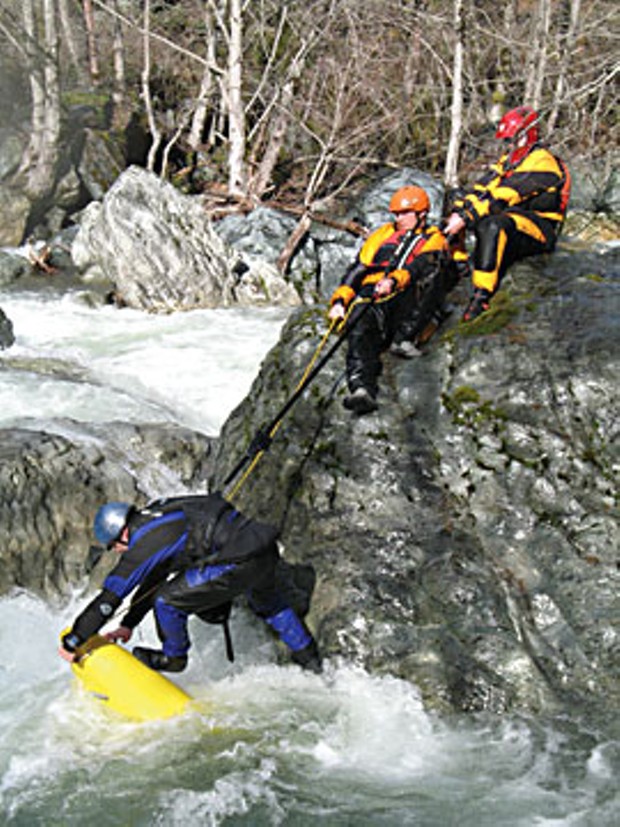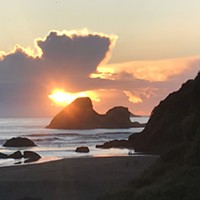[
{
"name": "Top Stories Video Pair",
"insertPoint": "7",
"component": "17087298",
"parentWrapperClass": "fdn-ads-inline-content-block",
"requiredCountToDisplay": "1"
}
]
Every kayaker needs a hometown run. That go-to river that you skate out of work a bit earlier than usual to paddle before it gets dark; a creek you can count on for fun when the rain starts to fall. Willow Creek is a standby run for North Coast kayakers, close enough to paddle a short stretch before classes in the afternoon or after a long day at work to shake off some stress. But even though it's close to home and lots of fun, it can catch even experienced kayakers off guard.
Highway 299 follows Willow Creek for much of its length east of Berry Summit, crossing the creek several times. It starts as a mere trickle, but after a few miles, it picks up energy and power as East Fork Willow Creek and Three Creek add water from the surrounding hills. It plies bedrock for most of the journey, tumbling in between steep walls and around big edgy boulders, rarely slowing down to rest.
A few weeks ago I paddled Willow Creek with some friends. When Dan came to pick me up in the morning, he came searching for coffee. "Any joe, bro?" I was happy to make him a cup of coffee because Dan is a guy you always want to have functioning at the maximum level. He can be the life of the party, and he can also save you, or your equipment on a difficult stretch of whitewater. We loaded my stuff into his gray pickup and headed east. For the duration of the trip he blasted Led Zeppelin, and we rocked out to hallmark '70s classics the whole way.
The plan: meet five other paddlers on Berry Summit and kayak a portion of Willow Creek known as the "Teacups." It's further upstream towards Berry Summit than the runs that kayakers typically do, with steeper drops and a few small waterfalls. It rained the whole drive from the coast, until we climbed nearly to the top of Berry Summit, where the rain slowly turned into snow.
We met up with the other crew at the overlook and continued on the journey east, driving through the snowflakes, already imagining the cold bite of the creek on our hands. We never even stopped at the Teacups, but instead blazed right past because the flow was too low.
We ended up stopping farther downstream at the put-in for the class V run that is more commonly paddled than the Teacups (whitewater is rated from I to V, V being the most challenging). The snow eventually stopped, but a blizzard of bright kayaks and colorful equipment began to appear around us as we started to unpack our gear and get dressed. After a couple people ran a vehicle down to the take out, we got into the chilly water, just as the sun began to poke holes in the clouds.
The creek started out with a warm up section. Some boulders to dodge, braided channels to choose from, and a lot of bumping around on exposed rocks. The emerald green water of the creek lazily lapped mossy rocks adorned with forests of ferns. Alder trees held their ground against the power of the creek, refusing to budge an inch.
Soon after the put-in, we came to the Limbo, a fir tree stretched across the creek just high enough off the surface to allow a kayaker to lie back on the stern of the boat and slip under. The flow of the creek was higher than the last time I paddled it, and after I went under I was thankful that I didn't rake my face on the underside of the tree.
Shortly after we ran the warm up section, we stopped to scout a rapid known as "Car Hood." There's a line that you can take on the right, but from what I've been told those that have run it on that side rarely make it look good. In general, when you paddle difficult rapids it's important that the routes that you take look and feel smooth, otherwise accidents are more likely to happen. Lately, Dan has been running Car Hood to the far left, so the rest of us watched as he charged the rapid, making it look far easier than it probably was. On this particular day everybody else decided that it was too dicey, so we walked around the cascade and got back in the creek downstream of it.
We ran several more rapids after Car Hood, one of the most notable of which was a drop called "Eraser Face," named for its potential to throw a kayaker face-first into a jagged boulder near the end of the rapid. Some in the group "stuck the line," boofing to the left of a stream of water that rushes upward off a rock (kayaks make the sound "boof" when they land flat). Others, coming perilously close to losing part of their face on the rock, went farther right and plunged deep into the hole below, disappearing entirely from view, only to surface an instant later farther downstream.
After several more drops and tight turns around impossibly large boulders, we came to the final rapid of the trip, known affectionately as "White Trash." It's a long and steep rapid roiling with whitewater. I was the last one to run the drop and I watched the paddler in front of me flip over. I could see from the way the boat was being jarred, bouncing up and down, that he was taking rocks to the helmet. After a missed roll and some more rocks to the helmet, he swam out of his kayak, and within seconds was safely on the bank of the creek.
His kayak and paddle, on the other hand, were not so lucky. Both wound up just a few hundred yards downstream from White Trash. We were able to get the paddle without too much hassle, but the boat was a different story. It managed to find one of the scariest, most gut-wrenching sieves I have ever seen in my life. A sieve is a hole in a rock, or a hole in between rocks, where water rushes through. They are the mortal enemies of river runners because of their potential to trap unlucky paddlers. In this particular sieve, a substantial volume of water swirls around in a whirlpool, pulling in everything that comes too close before disappearing underneath a truck-sized boulder.
One of the ends of the boat was sticking out of the water, so we had high hopes that it would not be difficult to retrieve. We hooked some safety ropes onto our friend and then lowered him down to the boat, where he attached a rope and carabiner to the grab loop on the kayak. Shortly thereafter, the boat slowly slipped farther under the surface, like the final moments of an ocean liner forever lost at sea. It was still visible just beneath the surface, but now it was farther down into the sieve.
For the next three hours, we tried everything that seven kayakers could possibly do to retrieve a boat. We set up multiple z-drags (rope and pulley systems used to obtain mechanical advantage) to trees from different angles, tangent ropes attached to the main rope, and seven people pulling with all their power. We even broke the carabiner that was attached to the kayak and reattached another rope to the helpless boat.
We were starting to run out of hope and options and decided that it would be best to try and recover the boat after the water level receded. We ended up leaving the rope attached to a tree and the kayak which, although clearly wedged in an awful place, was tantalizing close to the surface of the water.
Back at our vehicles, someone said to our friend, "Hey man, sorry that you lost your boat." After thinking about it for a few seconds I said, "Well, he didn't really lose it — it's just on loan."
Speaking of Outdoors
more from the author
-
Salmon River Race
Pirates v. Superheroes in the Klamath-Trinity wilds
- Jun 5, 2008
-
Rattlesnake Creek
Paddling an engineered river
- Jan 31, 2008
- More »



































